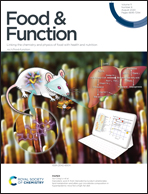Preventive effect of ethanol extract from Chinese sumac fruits against tetrachloromethane-induced liver fibrosis in mice†
Abstract
Chinese sumac (Rhus chinensis Mill.) fruits are traditionally used as a condiment and herb. The aim of this study is to evaluate the preventive effect of the ethanolic extract from Chinese sumac fruits against CCl4-induced liver fibrosis in mice and to delineate the underlying mechanisms. The results showed that the ethanolic extract substantially decreased AST, ALT, MDA, and hydroxyprolin (HYP), restored GSH, SOD, and CAT, and prevented liver fibrosis induced by CCl4. Further, investigation revealed that the prevention against liver fibrosis may be related to heightened inflammation due to suppression of the release of IL-1β, IL-6, and TNF-α, and the downregulation of COX-2, iNOS, p-NF-κB, and p-P38; the prevention of hepatocyte apoptosis was due to the upregulation of Bcl-2 and downregulation of Bax; the reduction of HSCs activation was due to the downregulation of TGF-β1 and upregulation of PPAR-γ; and the decrease in the extracellular matrix (ECM) deposition was due to the regulation of MMP9 and TIMP2. These findings proved that Chinese sumac fruits could effectively prevent CCl4-induced liver fibrosis in mice and may be used to develop functional foods and/or nutraceuticals to prevent or alleviate liver fibrosis.



 Please wait while we load your content...
Please wait while we load your content...